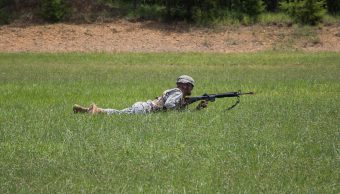FORT KNOX Ky.- Today, 1st Regiment, Basic Camp Cadets completed Fire Team Movement exercises. What exactly is Fire Team Movement? Why must Cadets learn how to properly execute the required exercises and when will it be useful throughout their career? These questions were answered by several Cadre and Cadets who partook in the event.
What is Fire Team Movement?
Cadet Rebecca Balzan of Mary Baldwin University, was more than eager to share what the exercises entailed. “Today, we are going through different lanes and it’s the first day of our FTX or Field Training Exercise. We have done about eight different lanes that are meant to prep us for field combat.
“All in all, we learned field exercises, file and wedge movements, proper hygiene in the field, insects that we need to be aware of, how to apply camouflage, how to properly walk through a wooded area with our team, indirect fire training, and formation,” she continued.

1st Regiment, Basic Camp Cadets performed Fire Team Movement training June 24, during Cadet Summer Training at Fort Knox, Ky. Photo by: Madison Thompson
What does field training exercises look like for the Cadets and why is it an important to learn? Spc. Casey Tankersley provided insight on that subject. “Some of the things we got going on is scenarios that require the Cadets to do a low crawl, a high crawl, or a three to five second buddy rush. This is important in a situation where they are being shot at and have limited cover they must know how to get into a certain position. Or if they’re in an open terrain, they must know how to get somewhere expediently, which requires a different kind of movement as well.”
Tankersley also added, “What we are trying to get them to take away from this experience is these are basic skills of a Soldier and once they get into advanced camp they’ll understand more of what it takes to be a leader. However, for this exercise we are just trying to get down to the basics. This teaches them discipline and basic values they can use throughout their everyday life.”
As mentioned above, another exercise the Cadets completed during Fire Team movement is the indirect fire exercise. “This event is called Indirect Fire training. Basically, this training teaches the Cadets what to do in the circumstance of indirect fire. It’s actually a good was for us to challenge them to communicate well with their teammates and do the natural reactions of what we want them to do when they hear indirect fire,” explained 2nd Lt. Khory Wheat.
Wheat explained the specific steps that are required of the Cadets in this particular situation. “We have a whistle and indicator that simulates what they would hear in the field, which makes it more real for the Cadets.”

1st Regiment, Basic Camp Cadets performed Fire Team Movement training June 24, during Cadet Summer Training at Fort Knox, Ky. Photo by: Madison Thompson
“The first thing the Cadets are asked to do is yell incoming, which tells the entire unit that there is an incoming fire. The next step is for the Cadets to drop down to the ground, which creates a low silhouette so if indirect strikes they have a better chance at survival. After that they have to run through a rally.”
1st Regiment, Basic Camp Cadets advanced through Fire Team Movement and are ready to conquer the next obstacle.




